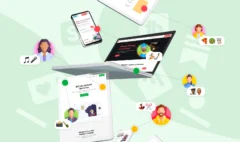How to Create Engaging and Valuable Content for Your Audience
How to Create Engaging and Valuable Content for Your Audience
Introduction
Content is the king of digital marketing, but not all content is created equal. To stand out from the crowd and achieve your marketing goals, you need to create content that is engaging and valuable for your audience. Engaging content is content that captures and holds your audience’s attention and makes them want to interact with your brand. Valuable content is content that provides useful information, entertainment, or inspiration to your audience, and helps them solve their problems or fulfill their needs.
But how do you create engaging and valuable content for your audience? In this article, we will share some tips and tricks on how to do that, from understanding your audience to planning your content, to measuring your results.
1. Understand Your Audience
The first step to creating engaging and valuable content is to understand your audience. You need to know who they are, what they want, and how they behave. To do that, you can:
- Conduct audience research: Use tools such as surveys, polls, interviews, or analytics to collect data and insights about your audience, such as their demographics, psychographics, behaviors, and interests.
- Create audience personas: Use the data and insights you gathered to create audience personas, which are fictional representations of your ideal customers, based on their characteristics, goals, and challenges.
- Map the customer journey: Use the audience personas you created to map the customer journey, which is the process your customers go through from becoming aware of your brand to making a purchase, to becoming loyal advocates.
Understanding your audience will help you create content that resonates with them and meets their expectations and needs.
2. Plan Your Content
The next step to creating engaging and valuable content is to plan your content. You need to know what type of content you want to create, what topics you want to cover, and what goals you want to achieve. To do that, you can:
- Define your content goals: Use the SMART framework to define your content goals, which are specific, measurable, achievable, relevant, and time-bound, and align with your overall marketing goals.
- Conduct keyword research: Use tools such as Google Keyword Planner, Moz, or SEMrush to conduct keyword research, which is the process of finding and analyzing the words and phrases that your audience uses to search for information online.
- Create a content calendar: Use tools such as Google Calendar, Trello, or CoSchedule to create a content calendar, which is a document that outlines your content plan, such as the type, topic, format, and schedule of your content.
Planning your content will help you create content that is relevant and timely for your audience, and helps you achieve your goals.
3. Create Your Content
The most important step to creating engaging and valuable content is to create your content. You need to know how to craft and format your content, and how to optimize it for your audience and platforms. To do that, you can:
- Follow the best practices: Follow the best practices for creating engaging and valuable content, such as:
- Use catchy and clear headlines that capture your audience’s attention and curiosity.
- Use compelling and informative introductions that summarize your main points and benefits.
- Use subheadings, bullet points, and images to break up your content and make it scannable and easy to read.
- Use storytelling, examples, and data to support your arguments and make your content more interesting and credible.
- Use a clear and consistent tone and voice that matches your brand and audience.
- Use a strong and clear call to action that encourages your audience to take the next step, such as subscribing, sharing, or buying.
- Choose the right format: Choose the right format for your content, depending on the type, topic, and platform of your content, such as:
- Blog posts: These are written content that are published on your website or blog, and are ideal for providing in-depth information, education, or inspiration to your audience. They can also help you improve your SEO and drive traffic to your site.
- Videos: These are visual content that are published on platforms such as YouTube, Vimeo, or Facebook, and are perfect for providing entertainment, demonstration, or emotion to your audience. They can also help you increase your engagement and reach.
- Podcasts: These are audio content that are published on platforms such as Spotify, Apple Podcasts, or SoundCloud, and are great for providing conversation, interview, or education to your audience. They can also help you build your authority and credibility.
- Infographics: These are graphic content that are published on platforms such as Pinterest, Instagram, or Twitter, and are excellent for providing data, statistics, or facts to your audience. They can also help you boost your visibility and shareability.
- Optimize your content: Optimize your content for your audience and platforms, such as:
- Use keywords, hashtags, and tags to improve your content’s visibility and discoverability on search engines and social media.
- Use analytics, metrics, and feedback to measure your content’s performance and effectiveness on your audience and goals.
- Use tools such as Grammarly, Hemingway, or Canva to improve your content’s quality and appearance.
Creating your content will help you create content that is engaging and valuable for your audience, and helps you stand out from the crowd.
4. Distribute Your Content
The final step to creating engaging and valuable content is to distribute your content. You need to know how to share and promote your content, and how to reach and connect with your audience. To do that, you can:
- Choose the right channels: Choose the right channels for distributing your content, depending on the type, format, and goal of your content, such as:
- Your website or blog: This is your own channel, where you can publish and host your content, and drive traffic and conversions to your site.
- Email: This is a direct and personal channel, where you can send and deliver your content to your subscribers, and build relationships and loyalty with your audience.
- Social media: This is a social and viral channel, where you can share and spread your content to your followers, and increase your engagement and reach.
- Guest posting: This is an external and influential channel, where you can publish and feature your content on other websites or blogs, and expand your network and reputation.
- Use the best strategies: Use the best strategies for distributing your content, such as:
- Use a content management system, such as WordPress, HubSpot, or Hootsuite, to automate and streamline your content distribution process.
- Use a content distribution network, such as Cloudflare, Amazon CloudFront, or Akamai, to improve your content’s speed, security, and performance.
- Use a content marketing platform, such as ClearVoice, Contently, or Skyword, to amplify and optimize your content distribution and reach.
- Use a content syndication service, such as Outbrain, Taboola, or Zemanta, to republish and distribute your content on other websites or platforms.
- Engage with your audience: Engage with your audience after distributing your content, such as:
- Respond to your audience’s comments, questions, or feedback, and show your appreciation and interest.
- Ask your audience for their opinions, suggestions, or testimonials, and involve them in your content creation process.
- Encourage your audience to share, like, or recommend your content, and increase your word-of-mouth and referrals.
Distributing your content will help you create content that is engaging and valuable for your audience, and helps you achieve your goals.
Conclusion
Creating engaging and valuable content for your audience is not an easy task, but it is possible if you follow these four steps. You need to understand your audience, plan your content, create your content, and distribute your content. By doing so, you will be able to create content that is engaging and valuable for your audience and helps you stand out from the crowd. Remember, the key to creating engaging and valuable content is to provide value, support, or collaboration to your audience, and make them want to interact with your brand. Good luck!












